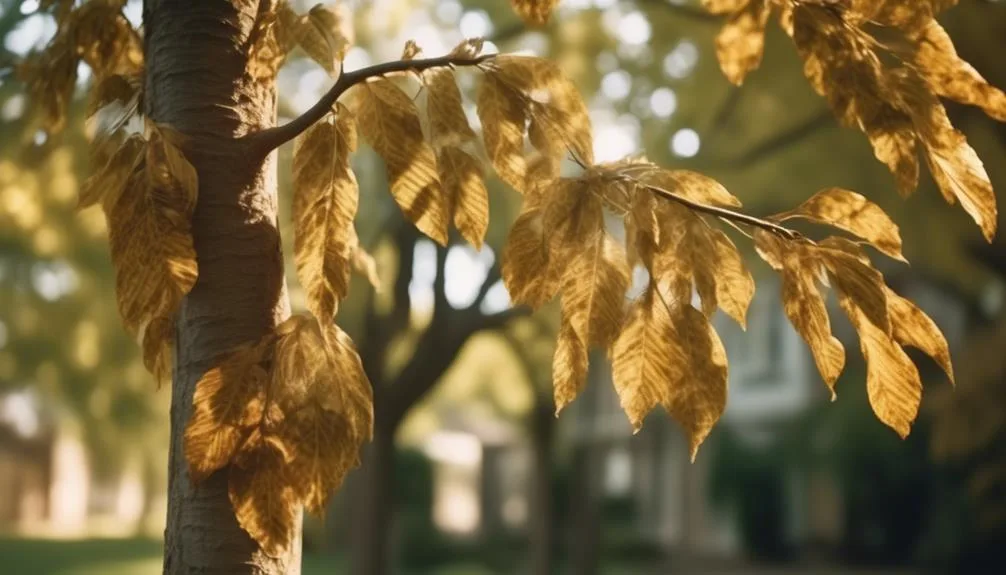Is your hickory tree looking sick? Discolored leaves and strange growths could be signs of trouble.
Understanding common hickory tree diseases is crucial to keeping your trees healthy.
But how can you treat these diseases and ensure your hickory trees stay strong?
Let's explore practical strategies and expert advice to protect your hickory trees from common diseases.
Identifying Common Hickory Tree Diseases
To identify common hickory tree diseases, observe the leaves, branches, and overall appearance for any signs of discoloration, wilting, or unusual growth patterns. Fungal infections often manifest as irregular leaf discoloration, including yellowing, browning, or black spots. Keep an eye out for any abnormal growths or powdery substances on the leaves, as these could indicate a fungal issue.
Additionally, pest infestations can cause bark damage, such as holes, tunnels, or chew marks left by insects. Check the bark for any signs of infestation, including sawdust-like residue, webbing, or insect activity.
Understanding Symptoms and Causes
Examine the hickory tree closely to identify symptoms of diseases or infestations, which may include:
- Irregular leaf discoloration
- Bark damage
- Unusual growth patterns
Early symptom identification is crucial for effective disease management. Leaf discoloration, such as yellowing, browning, or spotting, can indicate various diseases like anthracnose or leaf spot.
Additionally, bark damage, such as cracking or peeling, may be a sign of canker diseases or pest infestations.
Unusual growth patterns, such as stunted or distorted leaves, can also point to underlying health issues.
Understanding the causes of these symptoms is essential for implementing targeted treatment strategies. Disease causes can range from environmental stressors and improper care practices to specific pathogens or insect infestations.
Effective Treatment and Management
Inspecting the hickory tree for any signs of disease or infestation is crucial for effective treatment and management. Here are some steps to consider:
- Natural Remedies: Explore natural options such as neem oil or copper fungicides, which can help control certain diseases without the use of harsh chemicals.
- Chemical Treatments: Consider using chemical treatments like fungicides or insecticides, but be cautious and follow the instructions carefully to avoid harming the tree or surrounding environment.
- DIY Care: Regularly prune dead or infected branches, improve soil drainage, and ensure proper watering to promote tree health and reduce disease risk.
- Professional Intervention: If the disease persists or the infestation is severe, consult with a certified arborist who can provide expert diagnosis and treatment options.
- Monitor and Maintain: Keep a close eye on the tree's health, implement preventive measures, and maintain good tree care practices to minimize the risk of future diseases.
Prevention and Maintenance Tips
After evaluating the hickory tree for any signs of disease or infestation, it's essential to implement preventive measures and maintenance tips to safeguard its health and vitality.
Pruning techniques are crucial for maintaining the tree's structural integrity and preventing the spread of diseases. Regularly prune dead or diseased branches, making clean cuts to promote healing.
Additionally, keep an eye on the soil health around the tree. Ensure the soil is well-draining and rich in nutrients. Mulching around the base of the tree can help retain moisture and protect the roots. Periodically test the soil to check for nutrient deficiencies and pH levels, and amend the soil as needed.
Consulting a Professional Arborist
Consider seeking the expertise of a professional arborist to assess the hickory tree's overall health and provide tailored recommendations for its care and maintenance. Consulting a professional arborist can offer valuable insights and personalized guidance to ensure the health and longevity of your hickory tree.
Here are some key areas where a professional arborist can provide assistance:
- Diagnostic Evaluation: A professional arborist can accurately diagnose any diseases, pests, or structural issues affecting the hickory tree.
- Proper Pruning: An arborist can perform proper pruning to remove dead or diseased branches and promote healthy growth.
- Soil Care: They can assess the soil condition and recommend appropriate care measures, such as mulching and fertilization.
- Treatment Recommendations: Provide specific treatment recommendations tailored to the tree's needs.
- Long-term Care Plan: Develop a long-term care plan to ensure the hickory tree's continued health and vitality.
Conclusion
Incorporate the knowledge gained on identifying, treating, and preventing common hickory tree diseases to safeguard the health and beauty of your trees.
Stay informed, implement effective management strategies, and seek professional guidance for lasting tree care.
Mark Hoffman is a dedicated arborist and tree care specialist with over a decade of experience. His love for trees began when he visited Yosemite National Park as a teenager and was awestruck by the giant sequoias. Mark pursued his passion by studying forestry at Michigan Technological University, where he earned a Bachelor of Science degree.
Since then, he has worked tirelessly in the field of arboriculture, helping to preserve and protect trees in his community. His expertise and dedication have made him a respected leader in the industry and a valuable resource for anyone seeking advice on tree care.
